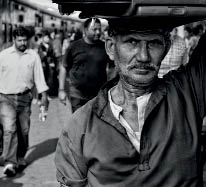Documentary

Documentary is that which aims at recording reality, attempting veracity in the depiction of people, places, and events. However, the process of mediation means that this is something of an oxymoron, it being impossible to represent reality without constructing a narrative that might be fictional in places. Certainly, any images that are edited cannot claim to be wholly factual; they are the result of choices made by the photographer. Decisions made in post-production mean that actuality is edited, resequenced, and artificially framed. The documentary maker generally establishes a thesis before starting the construction of what he wants to document, and the process of documentary-making could simply be the ratification of his idea. Perhaps, to misquote Eco, the objectivity of the picture lies not in the origin but the destination?
The documentary genre has a range of purposes, from the simple recording of events (a snapshot or unedited holiday video) to a polemic text that attempts to persuade the audience into a specific set of opinions (Bowling For Columbine). Audiences must identify that purpose early on and will therefore decode documentary differently than fictional narratives.
Documentary can be so much more than showing reality. It is also art. There are different modes of documentary, such as the “poetic mode,” “expository mode,” “observational mode,” “participatory ...

